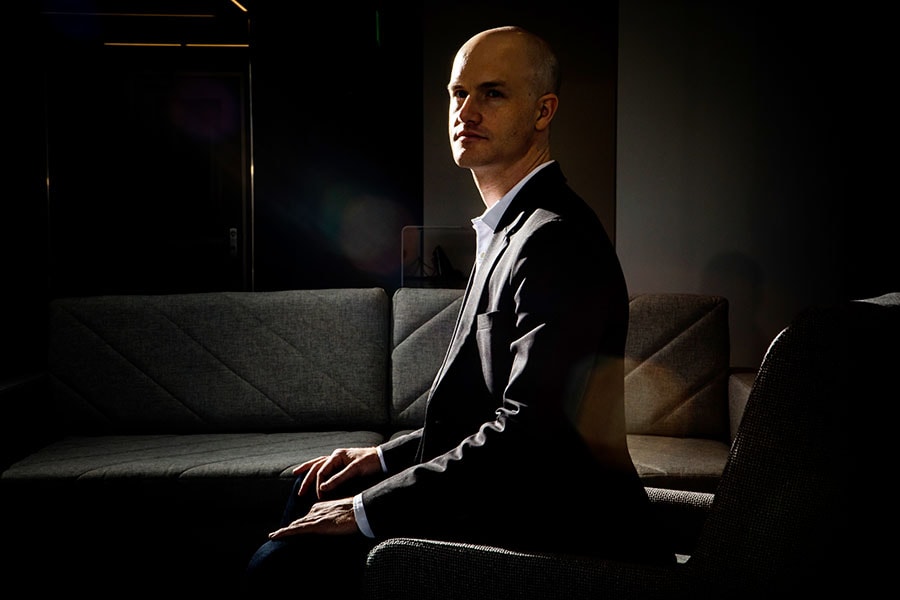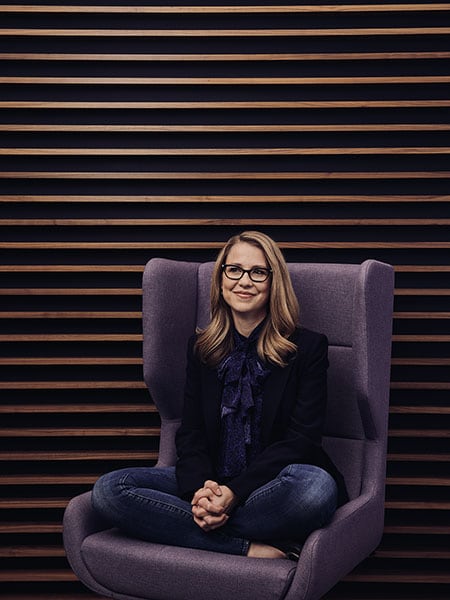Bitcoin's guardian angel: Coinbase's Brian Armstrong's quest for trust
For now, Coinbase looks like a casino, but its billionaire founder, Brian Armstrong, sees it as just the beginning of the financial liberation of the planet


 Image: Christie Hemm Klok for The Washington Post via Getty Images
Image: Christie Hemm Klok for The Washington Post via Getty Images
Near the foot of San Francisco’s California Street stand the august stone pillars of a bank dating to the 19th century.
A few paces away sit the offices of Coinbase, the largest American exchange for cryptocurrencies like bitcoin. It’s a beehive of software engineers and young marketing executives. There, the worlds of by-the-books banking and crypto-anarchism collide.
In style and philosophy, Brian Armstrong, the 37-year-old billionaire co-founder and CEO of Coinbase, is in the camp of the financial anarchists. He sits, jammed alongside lieutenants, in a row of tiny desks resembling library carrels. He wears a black T-shirt, black pants and shiny white sneakers. He talks about a brave new world in which we are liberated from the shackles of giant banks and government-controlled money supplies. During an expansive interview, this usually reserved and press-shy entrepreneur declares why he got into this business: “I wanted the world to have a global, open financial system that drove innovation and freedom."
In following a business model, though, Armstrong fits in with the pinstriped financiers working down the block. Eight years after its start, his firm has opened 35 million accounts, presides over $21 billion of assets and is on target, we estimate, to top $800 million in revenue this year.
That success comes from acting like a bank. Coinbase draws in customer funds via bank wires. It stores its assets—numerical keys that unlock coins—in vaults. It boasts of insurance coverage from Lloyd’s of London. It has a security staff of 41, including an Iraq War veteran assessing perimeter risks and a PhD. cryptographer doing the same for mathematical assaults.
The selling proposition here is security—security conspicuously lacking at some of the exchanges with which Coinbase has competed. The Mt Gox exchange in Japan went bust in 2014 after hackers spirited away coins worth $480 million. Customers of QuadrigaCX, which was one of Canada’s largest exchanges, have been unable to retrieve $150 million in crypto since the founder supposedly died suddenly in December 2018, holding the only set of keys to unlock their money. They now want the body exhumed.
In order to capture a gilt edge, though, Armstrong has had to veer away from the anti-establishment ethos that got bitcoin going. He plays ball with government inspectors, for example.
The Coinbase compliance staff, already numbering 55, is expected to grow to 70 by quarter’s end. They comb through transactions looking for money laundering. They will conform to a controversial new rule that mandates a paper trail when customers move coins from one exchange to another. Coinbase dutifully sends 1099-K reports to the IRS on traders who in one year do 200 or more trades involving a combined $20,000 or more in proceeds.
Given all this snitching, how does Coinbase appeal to diehard crypto fans? One way is by having a menu that includes 26 newer currencies, some of which are explicitly designed to offer more privacy than bitcoin does. The other is a service, introduced in August 2018, that enables a customer to move bitcoin into a personal wallet exempt from know-your-customer and anti-money-laundering regulations.
“If you are an individual and you want to store your own cryptocurrency, you’re not a financial service business," says Armstrong, mindful of any US Financial Crimes Enforcement Network cops who might be listening. “And there are companies, including us, who provide tools for people to store their own cryptocurrency and use it."
*****
Born near San Jose to engineer parents, Armstrong displayed an entrepreneurial streak as early as grade school. He recalls being hauled into the principal’s office on charges of operating a candy-reselling venture on the playground. The business flings continued with a scheme to resell used computers and, after he earned a master’s degree in 2006 from Rice University, a startup that matched tutors to students. He worked on the education venture while living in Buenos Aires. “I had just decided, I’ve never been to South America. I want to travel for a year and try to work on this remotely as an adventure. Figure out what I want to do with my life," he says. “[It] was an interesting experience to see the financial system in another country like that, that had gone through hyperinflation." Coinbase’s chief operating officer Emilie Choi
Coinbase’s chief operating officer Emilie Choi
Image: Ethan Pines
Later, as a coder at Airbnb, Armstrong had his crypto epiphany. His employer was sending money to landlords in Latin America. He describes the process this way: “High fees... long delays... opaque. We’d try sending money to somebody in Uruguay and didn’t know how much would show up on the other side."
In 2010 he read the manifesto, published by a person (or persons) under the alias Satoshi Nakamoto, that proposed bitcoin as an underground currency. Its transactions are recorded on a ledger called the blockchain, maintained in duplicated computer files by a band of self-appointed
guardians called nodes. Disputes about transactions and ground rules are resolved by majority vote. The nodes are kept honest, and trouble-makers at bay, by requiring a participant in the network to engage in some arithmetic busywork before certifying a batch of transactions. A node who completes the arithmetic task is awarded a few new coins.
The busywork, called mining, did not interest Armstrong. But he did see an opportunity in the business of safeguarding the keys to the coins and setting up transactions. Anybody can do that with some readily available software, but if you mishandle the protocol, your coins will be stolen or lost.
Armstrong took a flyer on bitcoins, buying $1,000 worth at $9 a coin. The price sank to $2. He kept the faith.
Working weekends and late nights, Armstrong wrote code in Ruby and JavaScript to buy and store coins. He was doing for the bitcoin network what an earlier generation of programmers had done for the internet by creating browsers. Coinbase’s chief financial officer Alesia Haas
Coinbase’s chief financial officer Alesia Haas
Image: Ethan Pines
It was fun. Was it worth quitting his day job? A $150,000 capital infusion from Y Combinator, source of seed funding to Airbnb and many other illustrious startups, answered that question in 2012. Fred Ehrsam, a Goldman Sachs alum, joined the venture and gave Coinbase credibility with the banks that would be wiring money to it.
Venture capitalists, led by Andreessen Horowitz, have showered half a billion dollars on Coinbase. “It’s like if Google made Gmail for bitcoin," says Chris Dixon, an Andreessen partner who serves on the Coinbase board. “And that’s literally the way they described it."
Its last round of funding valued Coinbase at $8.1 billion. Ehrsam, 31, has since left Coinbase but retains a stake he keeps busy arranging venture capital for startups that aim to use cryptocurrencies and blockchains to build transaction networks for corporations.
*****
The essence of what Armstrong has in mind can be captured in the word ‘defi’, which stands for decentralised finance or, if you prefer, defiance of authority. Defi is supposed to reach into all aspects of wealth someday, supposedly, blockchains will support trading, peer-to-peer lending and loan collateralisation without the usual financial institutions as intermediaries. Intriguingly, Coinbase has a broker/dealer licence. Could it someday end-run stock exchanges? Maybe.
If the grand vision for Coinbase is to be a gateway to decentralised finance of all sorts, the revenue for now is coming from more mundane things like trading commissions. Coinbase allows amateurs to go in and out of crypto, or swap one crypto for another, for fees and spreads that come to 2 percent or so. At archrival Binance, these small-fry speculators would pay 90 percent less, but they’d be dealing with a firm that mostly inhabits the shadowy world of offshore finance. Malta-based Binance has only a small presence in the US.
Serious traders get a better deal. They use Coinbase Pro, a different platform that replicates the bid-and-ask order book of a stock exchange here the combined buyer and seller commission ranges from 1 percent for small trades down to 0.07 percent at the $100 million level.
Somewhat more than half of Coinbase Pro’s trading volume comes from algorithmic trading. Furious trading doesn’t look socially productive, but it lubricates the capital markets. Bid/ask spreads on bitcoins, now worth $9,300 apiece, are measured in dimes. In percentage terms, the crypto spread competes with the spread on the very liquid SPDR S&P 500 ETF.
The trouble with commission income is that it’s extremely sensitive to crypto prices. When bitcoin collapses, as it did in 2018, trading volume shrinks and the dollar revenue from each coin goes down.
So Coinbase is trying to create stable revenue streams to balance out the commissions. A big one, says Alesia Haas, the company’s chief financial officer, is coming from a custody operation for institutional clients. This digital warehouse, greatly expanded by Coinbase’s acquisition last August of Xapo’s institutional business, holds $8 billion of bitcoins and other cryptocurrencies.
A new revenue source is “staking". Here, the holder of certain coins, such as tezos and EOS, collects fees for confirming transactions on the network. There is no electricity-gobbling busywork calculation as with bitcoin, but some finesse is needed, because messing up the recipe causes the player’s stake to be confiscated.
Coinbase handles the details and splits stake revenue with its customers. It’s rather like a stockbroker lending out your margined securities to short-sellers, except that there you’re unlikely to get cut in on the revenue.
Another Coinbase product, called USD Coin, developed in partnership with cryptocurrency exchange Circle, lets customers put up US dollars in exchange for a cryptocurrency that has the same value but can be traded more quickly. The dollars in question earn interest that Coinbase shares with its customers.
Coinbase says it handled $80 billion of transactions last year. (Binance boasts of a daily volume that annualises to $1 trillion.) Is that enough for a profit? CFO Haas allows that the bottom line flits in and out of the plus column from month to month. But, she adds, if you exclude non-cash items like charges for goodwill amortisation and the hypothetical value of employee options, Coinbase has been solidly in the black for several years.
In a firm fixated on growth, the money goes out of the door almost as quickly as it comes in. Coinbase has quadrupled its staff to 1,000 since hiring chief operating officer Emilie Choi two years ago. At headquarters, construction workers can barely keep up with the new hires streaming out of the onboarding room. There are offices in New York, Dublin and Tokyo. And then there are bets on the future.
Choi, who came to Coinbase after doing business development at LinkedIn, has taken the venture capital portfolio from nothing to 60 firms. It includes Bison Trails in New York City and Alchemy in San Francisco, both aiming to help corporations use blockchains, and Amber Group in Shenzhen, China, which is applying artificial intelligence to cryptocurrency trading. Says Choi: “A lot of the stuff that we’re doing in the venture side of the house is things we probably wouldn’t do as a principal but that we think is really interesting."
Armstrong adds, “These venture bets could be huge, but we don’t know if they’re gonna work. And they actually should have a pretty high rate of failure. Otherwise, we’re not thinking big enough."
*****
Crypto has been condemned as rat poison by Warren Buffett, as a fraud by Jamie Dimon and the mother of all scams by doomsday economist Nouriel Roubini. Where’s the payoff to the economy?
It’s coming, Armstrong says. He posits a future in which thousands of startups use crypto to raise capital in a global marketplace no longer controlled by Wall Street firms. Within a decade, he predicts, the number of people participating in the blockchain economy will explode from 50 million to 1 billion. We are destined to enjoy a financial system that is “more global, more fair, more free and more efficient".
There is an emotional component to the quest for financial liberation. Coinbase’s newly hired chief product officer, Surojit Chatterjee, talks about what happened when India all but destroyed currency holdings in a surprise attack on the money supply. His 80-year-old father spent five hours in line to retrieve the equivalent of $30.
Many countries, including Mexico, Argentina, Russia and Cyprus, have perpetrated wealth confiscations of this sort, in which some store of value is frozen or forcibly converted into something less valuable. The US is an offender, too. Franklin D Roosevelt seized gold in 1933, replacing it with pieces of paper that have since lost 95 percent of their value.
Like gold, bitcoin is too cumbersome to be used as a means of exchange. The convoluted mechanism for adding transactions to the ledger means it takes 10 minutes to confirm a payment and that only four transfers can take place per second. You can’t run a global economy on that.
Solutions are on the way, Armstrong says. One is to consider bitcoin a store of value and add a layer atop it for transactions, much the way a quiescent base of vault currency and Federal Reserve deposits supports a torrent of checks and electronic payments in the banking system. The other is to create new digital currencies built with transaction speed in mind. Among the ones Coinbase supports are litecoin and bitcoin cash.
In December, Coinbase got a first-of-its-kind authorisation from Visa to issue debit cards that allow holders to make purchases at the 46 million locations (including ATMs) that accept Visa,
and have the money drawn from a Coinbase account holding cryptocurrencies. Initially, these debit cards will be available to residents of 29 countries, but not the US. Still, Coinbase could eventually develop its Visa authorisation into yet another business line: Issuing credit cards on behalf of other crypto exchanges.
Banks, meanwhile, aren’t missing the opportunity to redesign payment networks using old-fashioned dollars. Zelle, an instant-payment system run by a consortium of big banks, ran $187 billion of traffic last year, putting it well ahead of PayPal’s Venmo. Zelle is mostly aimed at retail clients doing things like splitting dinner tabs, but has handled transactions as large as $3.2 million.
No question, disruptive technology is coming to the banking system, and Coinbase will be a part of it. It is the only outfit to appear on both the Forbes Fintech 50 and Blockchain 50 lists. But Armstrong is going to have plenty of competition, starting with central banks, which are plotting their own digital currencies. Facebook hasn’t given up on Libra, which is intended to be a globally accessible digital currency backed by assets like dollars and euros.
Let a thousand flowers bloom, says Armstrong. “When I started Coinbase, most people thought [blockchain] was crazy. Governments and the old guard, the blue chips, are now investing in this technology. So let’s just say that’s a very good thing."
First Published: Apr 15, 2020, 11:55
Subscribe Now